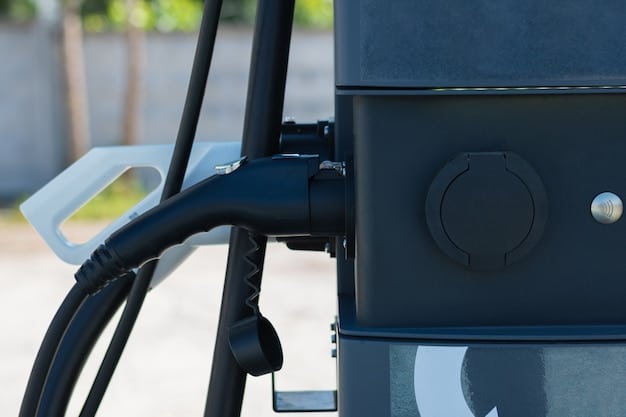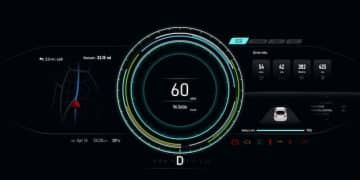What’s the Latest on the 2025 US Federal Tax Credit for Electric Vehicles?

The 2025 US Federal Tax Credit for Electric Vehicles includes updates from the Inflation Reduction Act, offering up to $7,500 in tax credits for eligible new and used EVs, focusing on domestic manufacturing and battery component sourcing.
Navigating the world of electric vehicles (EVs) can be exciting, but understanding the financial incentives available is crucial. Let’s dive into what’s the latest on the 2025 US Federal Tax Credit for Electric Vehicles?, and how it can impact your purchase.
Understanding the Basics of the Federal EV Tax Credit
The federal EV tax credit is designed to encourage the adoption of electric vehicles by offering a financial incentive to buyers. Understanding the basics, including eligibility criteria and the credit amount, is the first step in taking advantage of this opportunity.
This credit has evolved over the years, with significant changes introduced by the Inflation Reduction Act. Let’s break down the key components.
What is the Federal EV Tax Credit?
The federal EV tax credit is a tax incentive offered by the US government to individuals and businesses purchasing new or used electric vehicles. The credit aims to reduce the upfront cost of EVs, making them more accessible to a broader range of consumers.
Key Changes Introduced by the Inflation Reduction Act
The Inflation Reduction Act brought several significant changes to the federal EV tax credit, including adjustments to the credit amount, eligibility requirements, and vehicle sourcing stipulations. These changes are geared towards promoting domestic manufacturing and a more sustainable supply chain.
- Credit Amount: The maximum credit remains at $7,500, but it’s now divided into two parts: one for meeting battery component requirements and another for meeting critical mineral sourcing requirements.
- Income Limits: The act introduced income limits for buyers, restricting eligibility based on adjusted gross income (AGI).
- Vehicle Price Caps: There are also price caps for eligible vehicles, varying based on the type of vehicle (e.g., SUVs, trucks, vans, and cars).
- Sourcing Requirements: A significant portion of the EV’s battery components and critical minerals must be sourced from the US or countries with free trade agreements with the US.
In summary, the federal EV tax credit aims to incentivize EV adoption while promoting domestic manufacturing and sustainable sourcing. Buyers need to be aware of the evolving eligibility criteria to take full advantage of this incentive.

Eligibility Requirements for the 2025 Tax Credit
To qualify for the 2025 federal EV tax credit, both the vehicle and the buyer must meet specific eligibility requirements. These requirements are designed to ensure that the credit is targeted towards those who will benefit most and that it supports domestic industries.
Understanding these eligibility criteria is essential before making an EV purchase.
Vehicle Eligibility Criteria
The vehicle eligibility criteria include requirements related to where the vehicle is manufactured, its battery components, and its price.
- Manufacturing Location: The vehicle must be assembled in North America to qualify.
- Battery Components and Sourcing: A percentage of the battery components must be manufactured or assembled in North America, and a percentage of the critical minerals must be extracted or processed in the US or a country with a free trade agreement with the US. The percentages increase over time.
- Vehicle Price Cap: To be eligible, the vehicle’s manufacturer suggested retail price (MSRP) cannot exceed certain limits. For example, the limit for cars is $55,000, while for SUVs, trucks, and vans, it’s $80,000.
Buyer Eligibility Criteria
The buyer eligibility criteria primarily focus on income limits. These limits are based on the buyer’s adjusted gross income (AGI).
The income limits for claiming the tax credit are as follows:
- Single Filers: $150,000
- Head of Household: $225,000
- Married Filing Jointly: $300,000
If your AGI exceeds these limits, you are not eligible for the tax credit.
The eligibility requirements for the 2025 federal EV tax credit are multifaceted, encompassing vehicle manufacturing details and buyer income levels. Both aspects need to be satisfied to claim the credit.
How to Claim the EV Tax Credit on Your 2025 Taxes
Claiming the EV tax credit involves several steps, starting with confirming your eligibility and gathering the necessary documentation. Understanding the process can help ensure you receive the full credit you’re entitled to.
Let’s break down the steps.
Step-by-Step Guide to Claiming the Credit
Here’s a detailed guide to claiming the EV tax credit:
- Confirm Eligibility: Ensure both you and the vehicle meet all the eligibility requirements discussed earlier.
- Gather Documentation: Collect all relevant documentation, including the vehicle’s purchase agreement, VIN (Vehicle Identification Number), and any documentation related to your income.
- Fill Out Form 8936: Form 8936, Clean Vehicle Credits, is the form you’ll use to claim the EV tax credit. You can download this form from the IRS website.
- Submit with Your Tax Return: Include Form 8936 with your annual tax return. Ensure all information is accurately filled out.
Required Documentation and Forms
The documentation required to claim the EV tax credit includes:
- Purchase Agreement: This document confirms the date of purchase and the vehicle’s price.
- VIN (Vehicle Identification Number): This unique identifier is required to verify the vehicle’s eligibility.
- Form 8936: Clean Vehicle Credits.
- Income Documentation: Documents that support your adjusted gross income (AGI).
By following these steps and gathering the necessary documentation, you can successfully claim the EV tax credit on your 2025 taxes, reducing your tax liability and making your EV purchase even more affordable.
Impact of Battery Sourcing on the Tax Credit Amount
One of the critical aspects of the 2025 federal EV tax credit is the requirement for battery sourcing. The amount of the tax credit you can claim is directly influenced by how much of the vehicle’s battery components and critical minerals are sourced from the US or countries with free trade agreements with the US.
Let’s delve into this aspect further.
Understanding Battery Component and Critical Mineral Requirements
To receive the full $7,500 tax credit, EVs must meet specific requirements for battery components and critical mineral sourcing. The credit is divided into two parts:
- $3,750 for Battery Components: This portion of the credit is awarded if a certain percentage of the battery components are manufactured or assembled in North America.
- $3,750 for Critical Minerals: This portion is awarded if a certain percentage of the critical minerals are extracted or processed in the US or a country with a free trade agreement with the US.
The required percentages increase over time, encouraging manufacturers to shift their supply chains.
How Sourcing Affects the Credit Amount
If an EV meets only one of these requirements, it is eligible for only half of the tax credit ($3,750). If it meets neither requirement, it is not eligible for any tax credit.
The battery sourcing requirements are a crucial factor in determining the final tax credit amount. EV buyers should research the sourcing of their potential vehicle’s battery to understand the credit they may be eligible for.

Comparing the 2025 Credit with Previous Years
The federal EV tax credit has undergone several changes over the years. Understanding how the 2025 credit compares with previous years can help you appreciate the significance of the current incentives and make informed decisions.
Here’s an overview of the key differences.
Key Changes from Previous Years
The 2025 federal EV tax credit differs from previous years in several aspects:
- Income Limits: Previous versions of the tax credit did not have income limits. The introduction of AGI limits in 2023 means that only those below a certain income threshold are eligible.
- Vehicle Price Caps: Like income limits, vehicle price caps are a new addition, preventing the credit from being used for high-end luxury EVs.
- Battery Sourcing Requirements: The most significant change is the battery sourcing requirements. These incentivize domestic manufacturing and sustainable supply chains, a feature not present in earlier versions.
- Used EV Credit: The Inflation Reduction Act introduced a tax credit for used EVs, which was not available in previous years.
Benefits and Drawbacks of the New Regulations
The new regulations bring both benefits and drawbacks:
- Benefits:
- Promotes domestic manufacturing and sustainable sourcing.
- Ensures the credit is targeted towards those who need it most through income limits.
- Offers a credit for used EVs, making electric vehicles more accessible.
- Drawbacks:
- The complex battery sourcing requirements can make it difficult for some EVs to qualify for the full credit.
- Income limits may exclude some potential buyers who previously qualified.
In summary, the 2025 federal EV tax credit reflects a more targeted approach, balancing the goal of EV adoption with the need for sustainable and domestic manufacturing. While it offers new benefits, such as the used EV credit, it also introduces complexities that buyers need to navigate.
Tips for Maximizing Your EV Tax Credit
To make the most of the 2025 federal EV tax credit, strategic planning and careful consideration of your circumstances are essential. Here are some tips to help you maximize your credit:
Let’s explore some tips.
- Check Vehicle Eligibility: Before purchasing an EV, verify that it meets all the eligibility requirements, including manufacturing location, battery sourcing, and price caps.
- Understand Income Limits: Be aware of the income limits and how they apply to your AGI. If your income is close to the limit, consider strategies to reduce your AGI, such as contributing to retirement accounts.
- Consider Timing: Time your purchase strategically. Tax credits are non-refundable, so ensure you have enough tax liability to offset the credit.
- Explore State and Local Incentives: In addition to the federal tax credit, look into state and local incentives. These can further reduce the cost of your EV.
By following these tips, you can boost your chances of maximizing your EV tax credit, making your transition to electric mobility more affordable and beneficial.
| Key Point | Brief Description |
|---|---|
| 💰 Credit Amount | Up to $7,500 for eligible new EVs, split between battery components and minerals. |
| 📍 Sourcing Rules | Battery components & minerals must be from US, or free trade agreement countries. |
| 💼 Income Limits | AGI limits: Single ($150k), Head of Household ($225k), Married Jointly ($300k). |
| 🚗 Price Caps | MSRP limits: Cars ($55k), SUVs, Trucks, Vans ($80k). |
FAQ: 2025 US Federal EV Tax Credit
▼
For single filers, the income limit is $150,000. For heads of household, it’s $225,000, and for those married filing jointly, it’s $300,000. These limits are based on your adjusted gross income (AGI).
▼
Yes, the EV must be assembled in North America to be eligible for the tax credit. This requirement aims to support domestic manufacturing.
▼
Form 8936, Clean Vehicle Credits, is the form used to claim the EV tax credit when you file your taxes. It requires information about the vehicle and confirms your eligibility.
▼
To get the full $7,500, a certain percentage of battery components must be made in North America, and critical minerals must be sourced from the US or free trade countries. Partial credit may be available if only one condition is met.
▼
Yes, the Inflation Reduction Act introduced a tax credit for used EVs. However, there are specific requirements, including a price cap of $25,000 and different income limits compared to new EVs.
Conclusion
The 2025 US Federal Tax Credit for Electric Vehicles offers a significant opportunity for those looking to transition to electric mobility. By understanding the eligibility requirements, sourcing rules, and how to claim the credit, you can make an informed decision and potentially save thousands of dollars on your EV purchase.





